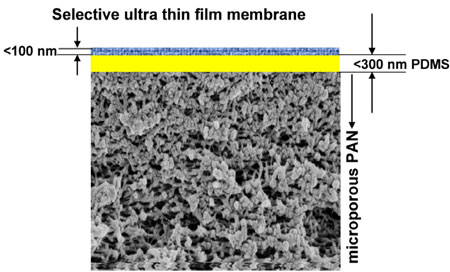| Posted: Sep 21, 2010 | |
Carbon dioxide capture with nanometric thin-film membranes |
|
| (Nanowerk Spotlight) The burning of fossil fuels like coal and oil pumps billions of tons of greenhouse gases into the atmosphere annually, changing the world's climate in the process. It is estimated that approximately one third of total world carbon dioxide emissions come from energy production in power plants. One possible option for reducing CO2 emissions from power plants is to capture them before they hit the atmosphere and store the gas underground. This technique is called Carbon Dioxide Capture and Storage. | |
| However, before CO2 can be stored, it must be separated from the other waste gases resulting from combustion or industrial processes. Most current methods used for this type of filtration are expensive and require the use of chemicals. Nanotechnology techniques to fabricate nanoscale thin membranes could lead to new membrane technology that could change that. | |
| Current membranes are in many cases not competitive for large scale applications, because their permeance (flux) for carbon dioxide is not high enough; state-of-the-art membranes exhibit a carbon dioxide permeance of about 0.3 m3 (STP) m-2 h-1 bar-1. | |
| Researchers in Germany have now reported the development and manufacturing of nanometric thin film membranes with record performance. By combining a CO2-philic polymer design with controlled nanofabrication conditions they have achieved defect-free selective layers far thinner than 100 nm. These membranes exhibit unmatched high CO2 permeance combined with high selectivity and stability. | |
| Reporting their findings in the September 1, 2010 issue of Nanotechnology ("Nanometric thin film membranes manufactured on square meter scale: ultra-thin films for CO2 capture"), researchers from the Institute of Materials Research and Institute of Polymer Research, both at GKSS-Research Centre Geesthacht, have fabricated multiblock copolymers consisting of polyethylene oxide and polybutyleneterephtalate into thin-film composite membranes on laboratory and technical scales. | |
 |
|
| Schematic representation of the thin-film membrane. (reprinted with permission from IOP Publishing) | |
| In order to manufacture their ultra-thin defect-free coatings with extremely high CO2 permeance and high selectivity, the researchers used a highly permeable intermediate layer (PDMS; thickness <300 nm) between the microporous support and the selective coating. The highly permeable intermediate layer worked as a gutter and protective coating which prevents the diluted polymer solution penetration into the porous structure, and at the same time renders the entire membrane surface smoother. | |
| To test the performance of their membranes, the GKSS researchers performed experiments with gas mixtures in order to evaluate the application in power plants. They found that their ultra-thin film membrane has roughly a 20 times higher CO2 permeance than commercial membranes, combined with one of the highest CO2/N2-selectivities known (facilitated transport materials excluded). | |
| According to the team, a preliminary technical and economical analysis shows that this membrane has potential for carbon capture in coal-fired power plants. They note that the capture cost using the conventional amine absorption process is in the range of 30-50 Euro per tonne recovered CO2. | |
| By applying a membrane-based process design the separation costs can be lower than 30 Euro/t using the high permeance membrane developed at GKSS. | |
| These membranes are currently under evaluation at pilot scale in a German project for CO2 capture in power plants. | |
 By
Michael
Berger
– Michael is author of three books by the Royal Society of Chemistry:
Nano-Society: Pushing the Boundaries of Technology,
Nanotechnology: The Future is Tiny, and
Nanoengineering: The Skills and Tools Making Technology Invisible
Copyright ©
Nanowerk LLC
By
Michael
Berger
– Michael is author of three books by the Royal Society of Chemistry:
Nano-Society: Pushing the Boundaries of Technology,
Nanotechnology: The Future is Tiny, and
Nanoengineering: The Skills and Tools Making Technology Invisible
Copyright ©
Nanowerk LLC
|
|
|
Become a Spotlight guest author! Join our large and growing group of guest contributors. Have you just published a scientific paper or have other exciting developments to share with the nanotechnology community? Here is how to publish on nanowerk.com. |
|
